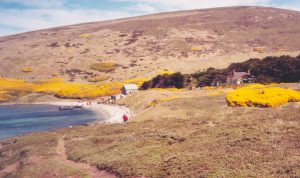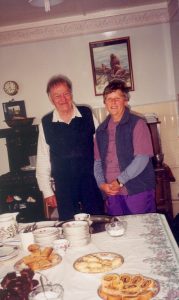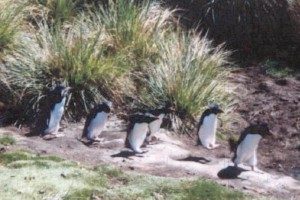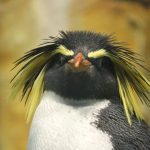- Introduction to Antarctica
- 1. First Stop, Falkland Islands
- 2. Penguins
- 3. Crossing Drake Passage
- 4. A Foothold on Antarctica
- 5. First Steps on the Continent
- 6. Crossing Paths of Explorers
- 7. Penguins and More Penguins
- 8. Pink Poop and Adélie Thieves
- 9. Stormy Finale
- 10. Changing Times
2. Penguins
Imagine my relief to discover that Clipper Adventurer, our home for the next twelve days, was relatively small for a cruise ship. I’d seen photos of her, but I also had stood next to one of the mega-cruise ships docked in Portland near where I paddle dragon boats on the Willamette River. These ocean cruisers often have ten passenger decks, and accommodations for more than 3,000 people, the size of a small city. I could barely breathe thinking of all the people wandering around on that huge ship, worse than a city because they could not leave town for the weekend.

At 133-feet long, Clipper Adventurer held only 120 passengers. Not all of them showed up because our tour took place about two months after the attack on the World Trade Center. A smaller group of passengers was icing on the cake in my mind. All my residual anxiety faded when I realized I did not have to fight a crowd to eat, or find a seat for lectures, or get a spot on a shore boat. Also, I was reassured knowing Clipper Adventurer had been built for travel in polar regions with stabilizers for the rough seas and a reinforced hull, sturdy enough to bump aside small chunks of ice.
Once on board, a crewmember showed me to my cozy room in the bowels of the ship where my red jacket awaited me, placed conspicuously on my bed. The photos I’d seen of tours to Antarctica always showed people in bright red jackets. When I signed up for the tour, I found out I would receive my own red jacket when I boarded the ship. I expected the weather would be so harsh that no jacket I owned would be good enough. Images of the explorers one hundred years earlier with icicles dripping off their beards caused me to put my faith in our ship provisioner. I trusted he would know best what we needed to survive. My jacket’s bright red fabric made of a sturdy material would cut the wind well, and I loved the fleece lining since I am so often cold. When I tried it on, I really knew I was on my way to Antarctica.
Our tour guides did not mention that we might not need our red jackets for every outing. When we boarded the ship in the Falkland Islands, we wore light jackets from home against the stiff breeze, but the daytime noon temperature was 66º F, a pleasant summer day for the area. Despite the mild weather, I thought, Here I am in the Antarctic, (Technically, we weren’t quite there yet.) I’ll need this heavier jacket.
Thinking about it now, I have to laugh about my affinity for my red jacket!
In time, I learned that the red jackets had a dual purpose; in addition to warmth, they allowed the crew to keep better track of us on land. From the ship, the duty crewperson could see our little red spots and radio someone on shore if a problem arose. Our bright red showed up quite well against bare rocks or snow, especially when we reached the Antarctic Peninsula. We had heard the story of one tourist who had decided to commit suicide by walking away from the group and staying on shore, but his red jacket gave him away. During our day excursions on land, no one wandered far from the group, but there were times when some people found it difficult to obey the rule to stay fifteen feet away from wildlife. When we reached Antarctica, I only heard a naturalist shout out once to a red figure on the next ridge creeping too close to a cluster of penguins, camera poised for the photo of a lifetime.
While we slept that first night on board Clipper Adventurer, the captain navigated the ship about 160 miles north and west around the archipelago from Stanley, and anchored off Carcass Island. This seven-square-mile island is located in the northern most collection of tiny islands that are part of the Falklands. At breakfast on the ship, we spotted our first penguins, only small dots on the distant shore that wobbled like penguins. What a thrill to see them in their own environment, so different from those confined in a zoo. I couldn’t wait to see them up close!
Our First Shore Excursion & Penguins!
 We soon boarded rubber Zodiacs that shuttled us ashore ten at a time to Carcass Island. Cheered by the sun, the howling wind and small white caps did not deter us. Julio Preller, our landing boss, pointed out some Magellanic Penguins scattered among the shore grasses that looked as if they were greeting our arrival. Many of them stood on humps of tussock grass that hid and protected their burrows dug into the roots of the tough grass. Like all penguins, they had black backs and white fronts, but the extra black stripe across the chest of these Magellenic Penguins distinguished them from other penguins. I thrilled at being so close to penguins, but it wasn’t until later that I could easily distinguish between the various species.
We soon boarded rubber Zodiacs that shuttled us ashore ten at a time to Carcass Island. Cheered by the sun, the howling wind and small white caps did not deter us. Julio Preller, our landing boss, pointed out some Magellanic Penguins scattered among the shore grasses that looked as if they were greeting our arrival. Many of them stood on humps of tussock grass that hid and protected their burrows dug into the roots of the tough grass. Like all penguins, they had black backs and white fronts, but the extra black stripe across the chest of these Magellenic Penguins distinguished them from other penguins. I thrilled at being so close to penguins, but it wasn’t until later that I could easily distinguish between the various species.
Once our boat reached the shore, Julio and his crew held the Zodiac’s fat sides steady, and helped us out. We waded ashore in the ankle deep water and once on shore, changed from our waterproof boots into hiking shoes. Julio reminded us when the last boat would return to the ship, and then left us on our own to explore.
Nearby, a Magallenic Oystercatcher with a long red bill, a black head and back, and a white belly, foraged for food, undisturbed by our presence. The red jackets ahead of us showed the way. We plunged into the sea of tussock grass, following the trail toward the island’s one farmhouse. On either side of the trail, nesting Gentoo Penguins watched us, unperturbed. The pairs had constructed nests of sticks, feathers, and grass. At each nest, one penguin stood to the side, often braying to the sky like a hoarse donkey. The other parent lay gently on the chicks to keep them warm. Gentoos are one of the larger penguin species, up to thirty-five inches in height, waist high if I could have gotten close enough to measure. They have a bright orange bill and a wide white strip across the top of the head.
Several globally endangered, but locally plentiful, Striated Caracara glided over our heads. This bird of prey feeds on carrion, so they nest near penguin and albatross colonies, ideal spots for finding a meal. We had visited the island after most penguin chicks had hatched that spring, and the caracara watched with hungry eyes for unguarded chicks.
Rob and Lorraine McGill, owners of Carcass Island since 1974, awaited our arrival at their farmhouse. The McGills had teatime for 75 people down to an art. People from the ship arrived in small groups, enjoyed the McGills’ hospitality, and then left as the next wave of visitors arrived. The hosts welcomed all of us with smiles, poured tea and warm milk, and refilled plates of cookies until all the stragglers finished their tea.

Our genial host Rob answered our questions about island living. “Well, you have to be self-sufficient and be able to repair most anything. It’s difficult to bring heavy bags of feed or fertilizer over from Stanley, so if we need to, we can hire a small boat.” Laughing, Rob noted, “Animals are the most difficult, you can imagine they don’t like to ride on a wobbly boat.”
“What about a medical emergency?” I asked because I have lived on an island and that is one of the disadvantages of the isolation.
“In a real emergency, we can get a military helicopter to come from Stanley, but that’s pricey and we aren’t rich here. I have a little boat I use for some of the trips. Usually we use my jeep to get over to the place where we keep the boat. It’s pretty bouncy and sometimes we get stuck in the soggy peat, but we make do.” He added, “If we just need to get around the island to check fences and so forth, we can use horses to travel across the soggy landscape.”
I had to chuckle to myself as I listened to Rob describe his love of the quiet on the isolated Carcass Island, far away from Stanley, as if it were “big city life,” yet only a block long! When we had stopped for lunch in Stanley the day before, it seemed pretty quiet to me, even with some 75 tourists in the area.
Rockhopper Penguin Colony
We returned to the ship for lunch while we sailed to Westpoint Island, a short distance south. All of us birders looked forward to observing the Rockhopper Penguincolony, located on the far side of the island.

Our Zodiac dropped us off on the shore, and we headed to another remote sheep farm for afternoon tea, this time with Roddy and Lily Napier. The Napier family first established a farm on the island in 1860 and their descendants have owned the island ever since. When we arrived, Roddy amiably posed for photos next to a table loaded with sweet biscuits and candies.
After a brief visit, Roddy offered the option of an island tour with him in his Land Rover. The island was only five square miles, so the tour fit our limited time schedule. A small group of our shipmates took him up on his offer. We birders were glad that most of the other passengers seemed content to wander along the beaches while we walked a little more than a mile to see the penguins. I carried my red jacket most of the way since it was too warm to wear. When we went ashore earlier that day, I wore my jacket and my heavy fleece like a true explorer. Before long, I became overheated and almost fainted. The crew must have had a good laugh at our naiveté since most of the other people wore their red jackets, just like I had.
On the west side of the island near a rocky outcropping called the Devil’s Nose, my friend Sally and I peeked over the edge of a cliff that plunged a long way down to the sea. A stiff wind whipped my hair into my eyes as I firmly planted my forward foot for safety, and cautiously looked over the cliff for a better view. Small black-and-white spots below me streamed up and down the rocky slope. Simon, one of the naturalists from the ship, told us those were the rockhoppers. He pointed to a small clearing nearby and suggested we wait in the head-high tussock grass for a close-up look at the penguins.
The wind cooled us quickly in spite of the balmy air temperature so Sally and I joined the other birders, tucked out of the wind. While we waited, masses of Southern Rockhopper Penguins and Black-browed Albatrosses 50-feet away on the cliff face, and to the right of our little meadow, entertained us with their activity. Both species brayed to the universe, heads pointed at the sky, greeting their mates returning from the sea. The sounds melded into one loud, overwhelming cacophony, though later I learned to identify individual calls and gestures that the birds made.
The black-browed albatrosses had a white body, and black wings when they were folded, with a faint black stripe flowing back from the eye like an eyebrow. Each pair had built a little pile of mud with a depression on top for an egg, but we were too early to see any of their eggs.

The rockhoppers prepared for breeding by moving around the small rocks that formed the nests. We learned more about those mobile rocks later in the trip. The penguins stood about two feet high, and weighed around six pounds, had red eyes, a short, reddish-brown bill, and pink feet. A crest of starched feathers crowned the back of a rockhopper’s head, like a crew cut. On either side, a rakish swish of bright yellow feathers cast back from above each eye to a fetching droop, fluttered as the wind caught them. Sally gave a raucous cackle, then said, “They look like a bunch of punk rockers on their way to a Halloween party.”
I agreed. They were such delightful creatures.
While rockhoppers can walk on flat land, they spend much of their time jumping up or down the steep rocky cliffs where they make their homes. They can hop up a rock face about half their own height from a standing start. It helps that they have strong claws and sandpaper feet to grip the rocky surfaces. On rocks close to us, we saw them jump down, sometimes further than the length of their little bodies.
A parade of rockhoppers ducked into the labyrinth of protective tunnels they had made at the base of the waving grass. Fifteen feet in front of our windbreak we could see an exposed, ten-foot section of the penguin path. Even before the first penguins waddled into view, we could hear their noisy braying and chattering. By the time the penguins arrived at this stretch of the path, they had hopped and plodded their way up the entire five-hundred-foot cliff.
The lead penguin spied us and stopped to study the gap in the grass. She turned back for a moment, uncertain, then forged ahead, sensing no threat. The group of about ten penguins continued their march, single file, toward their nests further up the cliff.

Close up, the rockhoppers reminded me of my two-year-old niece while she learned the finer points of moving forward. She pulled her arms back, thrust her chin forward, and toddled down the sidewalk slightly off balance. However, my niece could not hop up half her body height on the side of a cliff!
Simon answered our whispered questions as we waited. It seemed to me that the rockhoppers worked very hard to get up the cliffs, so I asked, “Why do they nest here? It’s so difficult to get up that cliff.”
“They always nest near steep rock gullies next to deep water,” Simon explained. “It is their niche in the penguin world.”
That made sense to me. Magellanic and gentoo penguins, both species bigger than the little rockhoppers, populated the sloping, sandy beaches we had visited on Carcass Island. It may have been a matter of survival for the rockhoppers to develop an affinity for the deeper offshore waters.
Penguin bodies are built to swim. Their tough wings evolved to speed them toward food in the water, and away from predators. Their short legs stream behind them when they swim, and their feet work as rudders. However, on land penguins must deal with gravity and a body not well designed for upright mobility. Penguin thighbones are short and fixed at the hip socket, so when they stand and walk upright, the bones are relatively parallel to the ground. Imagine your thighs fused at a right angle. You have to squat and tilt forward to get your center of gravity over your feet. In addition, drape a lot of flesh between your ankles, and try to walk. No wonder penguins look awkward.
A Last Look at the Rockhoppers
After leaving Westpoint Island, the ship sailed around the southern tip of land and into the bay where we watched through our binoculars as the rockhoppers climbed from the bottom of the cliff up to their nests, and back down again. From the aft deck of the ship, we could see the faint trail made by centuries of penguin toenail scratches winding up into the crown of grass. I watched one little rockhopper as she moved up the trail. She thrust her beak at an intended next step, maybe to examine the spot before leaping. She pulled back her flippers to balance against falling forward. Then, a hop that looked easy and her strong claws grabbed the new rock with amazing sureness. Half way up, the climb got tiresome for her. She pulled aside at a curve and flopped down on her fish-filled belly for a bit of a rest, then, onward and upward.
We saw three species of penguins in the Falkland Islands: rockhoppers, Magellanic, and gentoos. I wondered how many more we might see in Antarctica. With a last look at West Island, we retired to the dining room for the Captain’s dinner. He officially welcomed us aboard and introduced the crew, many of whom we had informally met already.
At last, we were on our way to Antarctica!